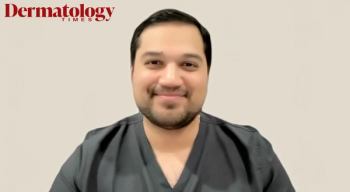
Amanda Caldwell, MSN, APRN-C, is promoting accessibility, education, and relatability as the newly inducted president of the Society for Dermatology Nurse Practitioners.

Amanda Caldwell, MSN, APRN-C, is promoting accessibility, education, and relatability as the newly inducted president of the Society for Dermatology Nurse Practitioners.

Jonathan Silverberg, MD, PhD, MPH, talks about therapies used for AD, including nemolizumab.

Julia Zimmermann, PD, PHD's innovative cold plasma technology for acne treatment, developed through extensive research, promises effective results for clearer skin.

Albert Chiou, MD, MBA, discusses early clinical data on soquelitinib for atopic dermatitis, highlighting its targeted ITK inhibition, dose-dependent efficacy, favorable safety profile, and more.

Discover how Julia Zimmermann, PD, PhD's PHLAS innovates cold plasma technology for skin care, enhancing treatments for acne and skin health.

Christopher Bunick, MD, PhD, discusses key differences in AD biologics and challenges in achieving optimal treatment targets.

Scott Batty, MD, and Chris VanDeusen, PhD, provided insights on AX-158's phase 2a results, presented at the SID Annual Meeting.

Raj Chovatiya, MD, PhD, MSCI, discusses how IL-13 and IL-31 inhibitors represent distinct yet complementary mechanisms in the management of atopic dermatitis.

Christopher Bunick, MD, PhD, explains why composite endpoints are now critical for evaluating patient outcomes in AD therapy.

Christopher Bunick, MD, PhD, discusses the evolving role of OX40-targeted biologics in atopic dermatitis treatment ahead of the upcoming RAD conference.

Raj Chovatiya, MD, PhD, MSCI, reviews the limitations of chronic steroid use and highlights available topicals, including ruxolitinib, roflumilast, and tapinarof.

Acting upstream of cytokines may hold the key to improving biologic efficacy and itch relief in AD.

Discover cutting-edge insights on atopic dermatitis at RAD 2025, featuring expert discussions and the latest therapies to enhance your practice.


Discover how the RAD conference in Nashville enhances atopic dermatitis care, featuring expert insights and patient-focused strategies for clinicians.

Alexandra Golant, MD discusses how addressing severe, recalcitrant atopic dermatitis remains the most pressing unmet need, with emerging biologics, oral JAK inhibitors, and combination therapies offering promising new approaches for these challenging cases.

Alexandra Golant, MD discusses how cost considerations, insurance barriers, formulary restrictions, and effective caregiver education about proper application will significantly impact the widespread adoption of ruxolitinib cream in pediatric dermatology practice.

Alexandra Golant, MD discusses how regulatory challenges, ethical considerations in pediatric clinical trials, and limited pharmacokinetic data present significant hurdles for pediatric treatment approvals, while topical ruxolitinib cream's targeted mechanism of action and steroid-sparing benefits make it a meaningful addition for younger children.

Alexandra Golant, MD discusses how the availability of topical ruxolitinib data in children as young as age 2 could potentially shift pediatric atopic dermatitis treatment guidelines by providing a non-steroidal alternative with a favorable safety profile.

Alexandra Golant, MD, discusses how advancements in pediatric atopic dermatitis (AD) treatment, including topical Janus kinase (JAK) inhibitors like ruxolitinib, may reshape guidelines, yet hurdles remain in regulatory approval, safety data, and accessibility. Adoption depends on efficacy, cost, insurance, and caregiver education. Unmet needs persist in long-term disease control and tailored pediatric options.

Raj Chovatiya, MD, PhD, MSCI, provides insights on the clinical advantages of JAK inhibitors for atopic dermatitis.

While products like growth factor skincare already have demonstrated benefits, this is only the beginning, according to Prithwiraj Maitra, PhD.

Prithwiraj Maitra, PhD, Vice President of Global Skincare R&D at Allergan Aesthetics, gave his thoughts on regenerative aesthetics and other recent skincare advancements.

Panelists discuss how the future of generalized pustular psoriasis (GPP) diagnosis and management looks promising with emerging genetic testing for IL36RN mutations, development of multiple targeted biologics beyond IL-36 inhibitors, potential personalized treatment algorithms, improved disease classification, and enhanced multidisciplinary care approaches to better address this rare but severe dermatological condition.

Panelists discuss how a high-risk patient with generalized pustular psoriasis requires a carefully tailored treatment approach that balances aggressive intervention to control acute flares with consideration of comorbidities, medication interactions, and long-term safety concerns, often necessitating multidisciplinary collaboration between dermatologists, intensivists, and other specialists.

Eichenfield discusses safety, lab monitoring, and treatment positioning of icotrokinra in adolescents with moderate to severe plaque psoriasis.

Strengthening interdisciplinary relationships remains a central part of Baker’s focus.

Anastasia Georgievskaya reflects on the success of SkinGPT and reveals upcoming plans and potential advancements in artificial intelligence and dermatology.

While dietary changes can help slightly, they’re not a cure-all for most patients with AD.

As a patient with rosacea herself, Anastasia Georgievskaya highlights the innovation of Generative Skin in patient education.